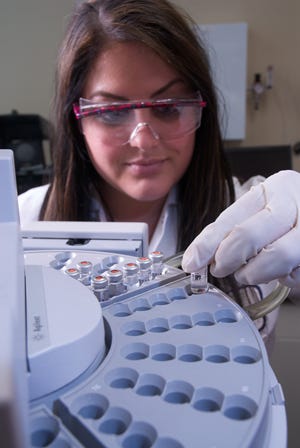September 30, 2014
There's been a change afoot in the medical device industry in the way companies test for biocompatibility--with a shift away from animal tests toward chemical characterization tests in the laboratory, according to Thor Rollins, a biocompatibility expert at Nelson Laboratories.
|
Nelson Labs analyst using a GC-MS to perform chemical evaluations. (Image courtesy of Nelson Labs) |
"It was only .... in the last year and a half that there has really been a strong push by the FDA to get involved. ... It wasn't until the FDA started asking for it that people have been doing it routinely," said Rollins, who is discussing biocompatibility and sterilization requirements during a series of sessions October 16 at MD&M Chicago.
The FDA's push for more chemistry behind leachables not only involves permanently implantable medical devices (implanted over 30 days) but also IV sets and sleep apnea devices that are passing fluid or air into the body, Rollins said. Class II and II is more of a concern than Class I.
Setting more standards for such testing was a top subject for a meeting of the Technical Committee 194 of ISO 10993 that Rollins attended last April.
The changes come amid greater concerns over the chemicals that leach into the body. One of the most notorious situations of leaching going badly involved metal-on-metal hip implants releasing cobalt and chromium into the body--producing tragic results in patients and billions of dollars in lawsuit payouts.
Leaching is likely to become even more of an issue because the more active babyboomer generation is needing medical device implants earlier, at the same time that it is expected to live longer. Devices, then, are going to be inside the body longer than in the past.
Animal tests are limited when it comes to figuring out whether chemicals leached from a device safe over a patient's lifetime, according to Rollins.
"We were limited on how aggressive on the solvents we could use in the animal tests, because we can't do something that's toxic in the animal. We have to use things like saline and oils. ... They're not very aggressive solvents," Rollins said.
With chemical tests, on the other hand, aggressive solvents such as methylene chloride can be employed to really stress the materials and determine worst case scenarios.
Tests use to chemically analyze materials include gas chromatography-mass spectrometry (GC/MS), liquid chromatography-mass spectrometry (LC/MS), ICP Mass Spectrometry (ICP-MS), and Fourier transform infrared spectroscopy (FTIR).
See Rollins and other experts speak at MD&M Chicago, Oct. 15-16 in Schaumburg, IL. |
ISO 10993 includes guidelines to help.
"You get a good fingerprint of what your device is, versus just extracting it in water and injecting it in a rabbit and crossing your fingers," Rollins said.
Chris Newmarker is senior editor of Qmed and MPMN. Follow him on Twitter at @newmarker.
Like what you're reading? Subscribe to our daily e-newsletter.
About the Author(s)
You May Also Like



